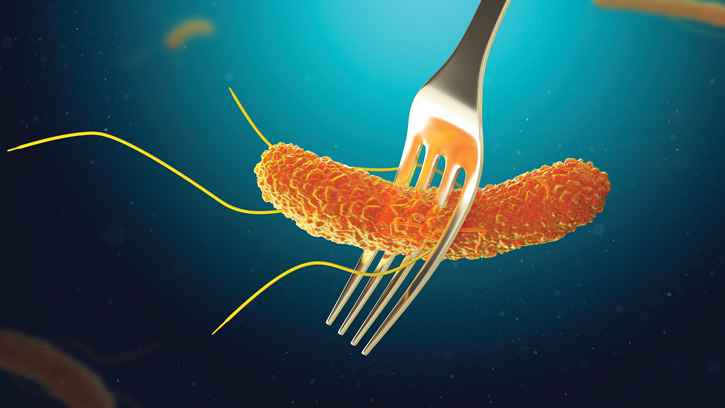Distinct ways to treat & prevent Salmonella Food poisoning.
Salmonella food poisoning is caused by certain bacteria in the Salmonella bacterium group. Both humans and animals’ intestines contain these microorganisms. When consumed, contaminated food or water with infectious excrement can cause human infection.

The small intestine is frequently impacted by a salmonella infection. Salmonella enterocolitis or enteric salmonellosis are other names for it. One of the most typical types of food poisoning is this one.
Every year in the US, 19,000 patients with salmonella food poisoning are hospitalised. People under the age of 20 are more likely to experience it. The Salmonella bacterium develops better in warm conditions, thus it’s also more likely to happen in the summer.
What causes salmonella food poisoning?
Salmonella food poisoning is brought on by consuming food or drinking anything that has been contaminated with specific types of Salmonella bacteria. Typically, infection occurs when a person consumes raw or previously handled food.
Salmonella is frequently transferred when people don’t wash (or wash their hands incorrectly) after using the restroom. Additionally, handling pets, particularly reptiles and birds, might spread it. Salmonella bacteria are destroyed by thorough cooking or pasteurisation. Consuming foods that are uncooked, undercooked, or unpasteurized puts you at danger.
Common triggers of salmonella food poisoning include:
- undercooked poultry such as turkey or chicken
- beneath-cooked eggs
- bottled juice or unpasteurized milk
- tainted fresh produce, nuts, or fruits
- Your chance of contracting salmonella can be influenced by a number of things, including:
- having a foodborne illness caused by salmonella in the family
- keeping a pet bird or reptile (they can carry Salmonella)
- living in communal spaces like dorms or nursing homes, where you are frequently exposed to a large number of people and other people preparing your food
- travelling to impoverished nations with subpar hygienic standards and inadequate sanitation
You are more susceptible to contracting Salmonella infection than most people if you have a compromised immune system.
Symptoms of salmonella
Salmonella food poisoning symptoms frequently appear fast, typically 8 to 72 hours after consuming contaminated food or drink. Aggressive symptoms may appear and may persist for up to 48 hours.
During this acute stage, typical symptoms include:
- abdominal discomfort, cramping, or sensitivity
- chills
- diarrhoea
- fever
- muscular ache
- nausea
- vomiting
- symptoms of thirst (such as decreased or dark-colored urine, dry mouth, and low energy)
- bloody faeces
Diarrhea-related dehydration is a severe concern, particularly in young children and newborns. Even one day can cause serious dehydration in the very young. Death may result from this.
How to manage the symptoms of salmonella?
The most crucial step in managing salmonella symptoms is to stay hydrated by drinking plenty of water. You can stay hydrated by drinking things like:
- Water.
- sports beverages.
- 100% fruit juice with additional water.
- Broth.
- Rehydration aids for the mouth (like Pedialyte).
Diarrhea in adults can be treated with over-the-counter drugs such loperamide (Imodium) and bismuth subsalicylate (Pepto-Bismol, Kaopectate). Children and newborns should not be given anti-diarrheal drugs without first consulting your paediatrician.
Treating salmonella food poisoning
The basic treatment for salmonella food poisoning consists of replenishing the electrolytes and fluids that are lost during diarrhoea. Adults should sip on ice cubes or drink water. Your paediatrician could advise rehydrating beverages for kids like Pedialyte.
Additionally, change your diet to just contain items that are simple to digest. Good choices include toast, rice, applesauce, and bananas. Stay away from dairy items and get lots of sleep. Your body can then fight the illness thanks to this. You may need to visit your doctor and obtain intravenous (IV) fluids if your nausea makes it difficult for you to drink anything. Infants and toddlers may also require IV fluids.
Antibiotics and medications to stop diarrhoea are typically not advised. Both the “carrier state” and the infection may be prolonged by these treatments. The time frame during and immediately following an infection during which you can spread the infection to another person is known as the “carrier state.” In order to control your symptoms, you should talk to your doctor about certain drugs. Your doctor might recommend antibiotics if the situation is serious or life-threatening.
Preventing salmonella food poisoning
Salmonella food poisoning can be avoided by:
- Treat food with care. Prepare food to acceptable internal temperatures, and instantly put leftovers in the refrigerator.
- Before and after cooking high-risk items, clean the counters.
- Clean your hands completely (especially when handling eggs or poultry).
- Separate utensils should be used for raw and cooked food.
- Before cooking, keep food chilled.
- Wear gloves or wash your hands properly after touching a reptile or bird you own.
People who work in the food service business who have salmonella should not come back to work until they have been free of diarrhoea for at least 48 hours.
Symptoms should disappear in two to seven days for healthy persons. The bacteria can, however, endure longer in the body. This implies that even if you don’t have any symptoms, you can still spread the Salmonella bacteria to other people.
REFRENCES:
- https://www.healthline.com/health/salmonella-enterocolitis
- https://www.mayoclinic.org/diseases-conditions/salmonella/symptoms-causes/syc-20355329
- https://my.clevelandclinic.org/health/diseases/15697-salmonella
- https://www.health.state.mn.us/diseases/salmonellosis/basics.html
For more details, kindly visit below.